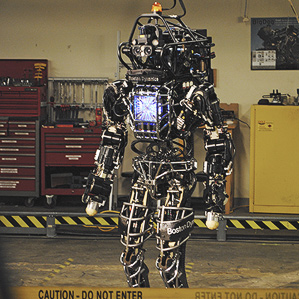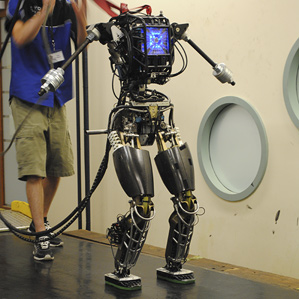ATLAS: The Robot with the World on its Shoulders
Despite the diversity of entries in the DARPA Robotics Challenge (DRC), there is one image that event followers are now well-familiar with. The celebrity face that keeps appearing whenever the DRC is brought up isn’t a DARPA official, or even the faces of the favored teams. Instead, it’s a jumble of metal bars and black plastic, punctuated by a pair of Wall-E-esque binocular eyes. The participants know him at ATLAS, the DARPA-designed robot that many teams just finished competing for in the DRC’s early rounds.
 While participants already feel like they know ATLAS personally thanks to the attention he’s received through the DRC, the final robot was only unveiled last Thursday at Boston Dynamics, out of Waltham, Massachusetts.
While participants already feel like they know ATLAS personally thanks to the attention he’s received through the DRC, the final robot was only unveiled last Thursday at Boston Dynamics, out of Waltham, Massachusetts.
When you take a step back, ATLAS’s exposed joints and skeleton looks like something out of sci-fi film, like an early model Cylon — and there’s a reason for that. Like the mechanical soldiers and laborers from the Battlestar Galactica Universe, ATLAS was designed to perform a vast array of human tasks the way humans would do them, such as driving a car or operating a fire hose. And since these devices were designed with human physiology in mind, it would follow that a robot would be most successful at these tasks if they too mimicked humans.
At the DRC, we can expect to see seven ATLAS robots competing amid a field of other specially designed robots, each with the goal of being the best robot to meet the needs that arise during disaster situations. Helping to differentiate the performances of the seven teams that have been awarded an ATLAS is the unique software that defines how the robot carries itself and carries out the tasks at hand.
Measuring in at six feet tall and weighing 330 pounds, ATLAS was clearly designed with strength in mind. Helping it to carry heavy objects and hold up its hefty frame are hydraulic-driven joints offering 28 degrees of freedom. And like its sci-fi Cylon counterpart, ATLAS sports two pairs of slightly different hands to help it perform a variety of tasks (except unlike the Cylon, and to the relief of those in fear of robotic rule, the alternate set of hands is not a gun).
Instead of using its superhuman strength to hold up the world or fight in a robot army, ATLAS is being put to the test through some of the most dangerous jobs there are: from working on a nuclear reactor during a meltdown to saving people from a collapsed building. DARPA was adamant that the robot will only be used for humanitarian missions, and has not been designed to perform any “adversarial” military tasks. The robot’s designers also expect for him to help shut off oil spills, or helping to snuff out a wildfire. And on the less dramatic but ever important end of the spectrum, some even anticipate that ATLAS could one day help care for the elderly and infirm.
DARPA notes that the robots were developed as a response to the Fukushima nuclear accident in 2011, after an earthquake and the following tsunami pushed a nuclear plant out of human control. At the time the agency did send over wheeled robots to attempt to help control the situation, but they were unable to complete many of the multifaceted tasks that were required. “We were tearing our hair out trying to help, and the truth is there was very little we could do,” explained DARPA program manager Gill Pratt during the unveiling.
 At Thursday’s event ATLAS flexed his hydraulic muscles by performing a number of calisthenics for the audience. The show might have been a bit noisy thanks to the robots weight and less-than-cushy design, but its not as ungainly as you might imagine. In a simulation that was also performed, an ATLAS model successfully inched along a narrow ledge, and could even walk over uneven terrain.
At Thursday’s event ATLAS flexed his hydraulic muscles by performing a number of calisthenics for the audience. The show might have been a bit noisy thanks to the robots weight and less-than-cushy design, but its not as ungainly as you might imagine. In a simulation that was also performed, an ATLAS model successfully inched along a narrow ledge, and could even walk over uneven terrain.
Previously, robots like ATLAS have strayed too far toward the ‘clumsy’ side to be dependable in high-stakes situations such as these, but according to Pratt, recent hardware and sensor improvements have represented a tipping point. “A number of technologies have gotten just good enough, or almost good enough, to make this thing work,” Pratt said as he indicated the robot’s interchangeable hands, and the sophisticated lidar navigation system that’s been built into its head.
Seth Teller, and Russ Tedrake, professors at MIT who are working in one of the ATLAS teams agreed. “It’s an extraordinary machine,” said Teller. “They’ve done a fantastic job on these machines; it’s been a real pleasure to see and touch and use the real hardware.”
Putting ATLAS aside, other robots in Boston Dynamics’ mechanoid zoo include a robotic pack mule called LS3, a wall-climbing gecko called RiSE, and the mechanical Cheetah that can sprint up to 29 miles per hour. Like many other robots, ATLAS relies on a tether, or umbilical cord of sorts, to provide it with cooling water and high-voltage power. However, Boston Dynamics plans to cut the cord in their enhanced 2014 model.
Some entrants in the DRC look more like these animal models than anything human, but for the most part, the thinking among teams seems to reflect the fact that to interface with human technology, the ideal robot should be human. Although we’ll have to wait for this December’s DRC Trials at the Homestead Miami Speedway to see which model ultimately proves the most capable.










